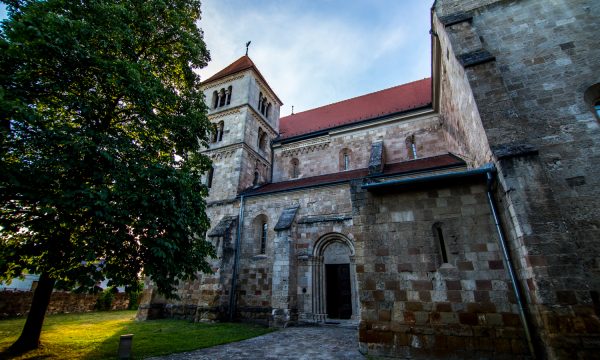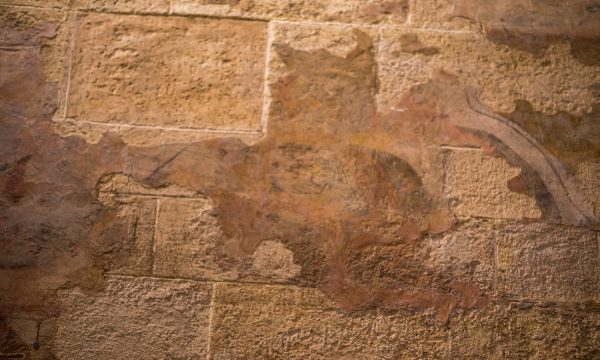Wall painting
The history of its construction is extremely complicated, so only the main building periods can be taken into account here. We find the first mention of the church in the Catalogus Ninvensis in 1234, but according to the researchers the construction of the provost church in Ócsa, founded from the provostry in Jászó, dedicated to the Blessed Virgin Mary started in the 1210’s.

In addition to its presumed royal foundation, some researchers do not exclude the possibility of its establishment by private owners. The construction works of the church with three naves, transept and two towers on the western side were probably completed at the beginning of the 1230s. The choir and the side aisles have polygonal closures. The destructions caused by the Tartar invasions certainly affected the church, but there are no data suggesting a major medieval reconstruction. A new larger tabernacle was created in the northern wall of its choir in the 15th century. The monastery lost its significance during the centuries of the late Middle Ages. It slowly became deserted, and didn’t even function at the beginning of the Turkish era. According to local tradition, the Turks transformed it into a mosque, but no traces of that were found during the research. During the Turkish occupation of Hungary, the Reformed congregation that had existed since the 1560’s, could use the church. Although its nave had no roof, services were held in the walled choir. We know of several Catholic attempts to take over the church in the 17th–18th centuries, but they were unsuccessful. Thanks to Queen Maria Theresa’s decision, through the good offices of Count József Teleki, a landowner in the village, the church remained in the hands of the Reformed community once and for all. Thanks to the Count’s powerful financial support, the building was restored between 1774 and 1777. In 1849 the master builders of Nagykőrös worked on the church, which presumably meant repair works on the roof. In 1872 damages were caused by lightning, which were only increased by the fire in 1884. In 1890 Oszkár Tandor prepared restoration plans, which were only carried out between 1897 and 1900. At the beginning of the 20th century the National Committee for Historic Monuments carried out various works on the church, from which the heightening of the towers with one level was the most significant one. This was carried out based on Ernő Foerk’s plans between 1922–24. In 1945 the helm roof of one of its towers was damaged. Its restoration as a historic building took place between 1986–95.

Its medieval murals were discovered during the restoration works carried out at the turn of the 19th century. They were uncovered between 1900 and 1902, and István Groh carried out the restoration of the mural fragments. In the choir we can see the figure of a saint who was a bishop (supposedly St. Nicholas). The composition depicting the Last Judgement is flanked on two sides by arched niches each divided into three bays by pilasters, displaying the standing figures of apostles, but the figure of St. George was also portrayed holding his shield with the cross. Only two scenes were preserved from the legend of St. Ladislaus on the northern wall. Only the scenes of the fight and the killing of the Cuman can be identified on the worn, incomplete surface. In addition to its figurative paintings, the medieval colouring of the capitals and its triumphal arch is also noteworthy. While according to some researchers the mural paintings date back to the last quarter of the 13th century, others say they date back to the beginning of the 1300s. It only adds to its significance that an early depiction of this cycle was not created in a parish church but in a Premonstratensian church, just like in Türje.
Natural Heritage
This ancient Hungarian settlement near Budapest possesses, besides its cultural riches, numerous natural treasures; “.. here begins a great bog, which extends for two miles, until Sár, its width being ¼ mile…” (Vályi, 1799). The defining element of Turjánvidék is water, which can be found, on the one hand, in the former beds of the Danube, and, on the other hand, in the depressions between sand ridges. Past attempts to drain these waters have, fortunately, largely been unsuccessful, and so these valuable habitats still remain.
Marshy, boggy habitats, ash, and alder swamp forests, oak, ash and elm grooves, fresh meadows and fens dominate the patchy landscape, which is home to diverse fauna and flora. The protected Urtica kioviensis is a creeping, slightly hairy, bright green plant of the local reeds and fens. Several orchids, like the military orchid (Orchis militaris) and the lax-flowered orchid (Anacamptis laxiflora) are also characteristic of these bogs, just like the fragrant orchid (Gymnadenia conopsea) and the early spider-orchid (Ophrys sphegodes). The purple-flowered Siberian iris (Iris sibirica) blooms in the spring, and at the lower altitudes we can find black bog-rush (Schoenus nigricans) and fen-sedge (Cladium) as well. An important ice age relict species is the ladybells (Adenophora liliifolia) belonging to the genus Campanula (commonly known as bellflowers). This bright blue flower, which can grow 1m tall, has become very rare and could become extinct in the near future.
A rare, native animal of the marshes is the woodlouse (Oniscidea). Most of the European population of centipedes (Chilopoda), living at higher altitudes, is also found here.
The common toad (Bufo bufo), the European fire-bellied toad (Bombina bombina), the agile frog (Rana dalmatina), and the European tree frog (Hyla arborea) are very numerous in these favourable habitats. The populations of the once common European mudminnow (Umbra krameri) and European weatherfish (Misgurnus fossilis) have diminished due to drainage and pollution.
Many water- and songbirds nest in the area. The Montagu’s harrier (Circus pygargus) lives in the fens, building its nest on tussocks or other high terrain features. The short-eared owl (Asio flammeus) and the distinctive sounding corn crake (Crex crex) also live in similar environments.
